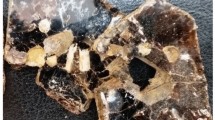Abstract
In this study, epoxy matrix composites containing mica with different particle sizes (40 and 80 µm) and quantities (0, 10, 20, 40 wt.%) were produced by the casting method. Composites were coated with a commercial agent imparting hydrophobicity in order to decrease water absorption. The bulk density and % open porosity values of the finished composites were determined by Archimedes' principle, and detailed microstructural analysis was carried out with scanning electron microscopy (SEM). The surfaces were characterized by the contact angle and roughness measurements. The durability and protective performance of the coating were quantified by the water absorption tests for various immersion times and temperatures (ASTM D570-98) and salt water resistance tests. Microstructure analysis showed that for all filler ratios and particle sizes, mica particles were homogeneously dispersed in the epoxy matrix and the mica–polymer interface was well bonded. It has been observed that the % theoretical density values of the composite products vary between 91.1 and 98.6%, and the total porosity varies between 1.4 and 8.87%. As the amount of mica increased, the total porosity also increased, regardless of the size of the mica particles. The neat epoxy matrix absorbed a higher quantity of water than composites in almost all cases, and the water absorption of the composites decreased with the increasing mica quantities and the decreasing particle size. The hydrophobic coating definitely caused the water absorption rates of the composite samples to decrease and the salt water resistance to increase, rendering them a convenient moisture- and corrosion-resistant composite material.







Similar content being viewed by others
References
Christenson HK, Thomson NH (2016) The nature of the air-cleaved mica surface. Surf Sci Rep 71(2):367–390. https://doi.org/10.1016/j.surfrep.2016.03.001
Şentürk E, Akçakale N, Okutan M (2016) Conductivity mechanism of mica powders inlaid elastomer based materials. J Alloys Compd 686:43–47. https://doi.org/10.1016/j.jallcom.2016.05.291
Kahraman M, Klzllcan N, Oral MA (2021) Influence of mica mineral on flame retardancy and mechanical properties of intumescent flame retardant polypropylene composites. Open Chem 19(1):904–915. https://doi.org/10.1515/chem-2021-0072
Trotignon J, Verdu J, Boissard R, Vallois A (1986) Polypropylene-mica composites. Polym Compos 9(6):191–198
Aarti More P Superabsorbent composites: a review, Polym Bull, pp.1–64, 2023,https://doi.org/10.1007/s00289-023-04809-2
Vu-khanh T, Sanschagrin B, Fisa B (1985) Fracture of mica-reinforced polypropylene : Mica concentration effect. Polym Compos 6(4):249–260. https://doi.org/10.1002/9781119865544.ch2
Vu-khanh and Fisa (1986) Fracture behavior of mica-reinforced polypropylene: effects of coupling agent, flake orientation, and degradation. Polym Compos 7: 219, doi: https://doi.org/10.1177/09544062211005798
Xia L, Wu H, Guo S, Sun X, Liang W (2016) Enhanced sound insulation and mechanical properties of LDPE/mica composites through multilayered distribution and orientation of the mica. Compos Part A Appl Sci Manuf 81:225–233. https://doi.org/10.1016/j.compositesa.2015.11.023
Anyszka R, Bielinski DM, Pedzich Z, Parys G et al (2018) Effect of mineral filler additives on flammability, processing and use of silicone-based ceramifiable composites”. Polym Bull 75:1731–1751. https://doi.org/10.1007/s00289-017-2113-0
Xiao C, Li D, Zeng D, Lang F, Xiang Y, Lin Y (2021) A comparative investigation on different silane coupling agents modified sericite mica/polyimide composites prepared by in situ polymerization. Polym Bull 78:863–883.
Hong TP, Lesaint O, Gonon P (2009) Water absorption in a glass-mica-epoxy composite - [I: Influence on Electrical Properties]. IEEE Trans Dielectr Electr Insul 16(1):1–10. https://doi.org/10.1109/TDEI.2009.4784545
O’Connor H, Dowling DP (2020) Evaluation of the protective performance of hydrophobic coatings applied on carbon-fibre epoxy composites. J Compos Mater 54(10):1327–1338. https://doi.org/10.1177/0021998319877454
Shi H, Liu F, Yang L, Han E (2008) Characterization of protective performance of epoxy reinforced with nanometer-sized TiO2 and SiO2. Prog Org Coatings 62(4):359–368. https://doi.org/10.1016/j.porgcoat.2007.11.003
Zou C, Fothergill JC, Rowe SW (2008) The effect of water absorption on the dielectric properties of epoxy nanocomposites. IEEE Trans Dielectr Electr Insul 15(1):106–117. https://doi.org/10.1109/T-DEI.2008.4446741
Scholz S, Kroll L, Schettler F (2014) Nanoparticle reinforced epoxy gelcoats for fiber-plastic composites under multiple load. Prog Org Coatings 77(7):1129–1136. https://doi.org/10.1016/j.porgcoat.2014.03.012
See SC, Zhang ZY, Richardson MOW (2009) A study of water absorption characteristics of a novel nano-gelcoat for marine application. Prog Org Coatings 65(2):169–174. https://doi.org/10.1016/j.porgcoat.2008.11.004
Acikbas G, Özcan S, Calis Acikbas N (2018) Production and characterization of a hybrid polymer matrix composite”. Polym Compos 39:4080–4093. https://doi.org/10.1002/pc.24471
Owens DK, Wendt RC (1969) Estimation of the surface free energy of polymers. J Appl Polym Sci 13(8):1741–1747. https://doi.org/10.1002/app.1969.070130815
Acikbas G, Calis Acikbas N (2021) Nanoarchitectonics for polymer-ceramic hybrid coated ceramic tiles for antibacterial activity and wettability”. Appl Phys A Mater Sci Process 127:1–11. https://doi.org/10.1007/s00339-021-04938-3
ASTM D570 (2014) Standard test method for water absorption of plastics. In: ASTM Standards, 98: 25–28
YamanCalis Acikbas BN (2018) Dry sliding behaviour of boron waste reinforced epoxy matrix composites”. J Boron 3:63–70. https://doi.org/10.30728/boron.343608
Özcan S, Açıkbaş G, Calis Acikbas N (2018) Induced superhydrophobic and antimicrobial character of zinc metal modified ceramic wall tile surfaces”. Appl Surface Sci 438:136–146. https://doi.org/10.1016/j.apsusc.2017.08.014
Liu W, Hoa SV, Pugh M (2005) Fracture toughness and water uptake of high-performance epoxy/nanoclay nanocomposites. Compos Sci Technol 65(15–16):2364–2373. https://doi.org/10.1016/j.compscitech.2005.06.007
Acknowledgements
This work was supported by the Mersin University Scientific Research Projects Coordination Office [grant numbers: 2022-1-TP2-4570].
Author information
Authors and Affiliations
Contributions
Gokhan Acikbas was involved in methodology, validation, interpretation of data, visualization, and resources; Kaan Sezer contributed to methodology and validation; Selçuk Özcan was involved in interpretation of data and revised it critically for important intellectual content, writing—editing; and Nurcan Calis Acikbas contributed to supervision, conceptualization, investigation, methodology, writing—original draft and approved the version to be published.
Corresponding author
Ethics declarations
Conflicts of interest
There are no conflicts to declare.
Additional information
Publisher's Note
Springer Nature remains neutral with regard to jurisdictional claims in published maps and institutional affiliations.
Rights and permissions
Springer Nature or its licensor (e.g. a society or other partner) holds exclusive rights to this article under a publishing agreement with the author(s) or other rightsholder(s); author self-archiving of the accepted manuscript version of this article is solely governed by the terms of such publishing agreement and applicable law.
About this article
Cite this article
Acikbas, G., Sezer, K., Özcan, S. et al. The effect of hydrophobic coating applied to mica reinforced epoxy matrix composites on the water absorption properties of the composite. Polym. Bull. 81, 6207–6224 (2024). https://doi.org/10.1007/s00289-023-04994-0
Received:
Revised:
Accepted:
Published:
Issue Date:
DOI: https://doi.org/10.1007/s00289-023-04994-0




